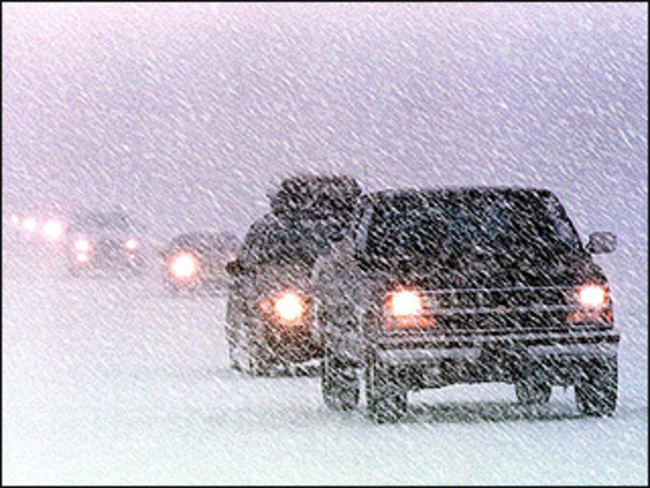Top 10 Winter Driving Safety Tips
It’s technically still winter, and it definitely still feels like winter in southern Ontario. With some more snow in the forecast over the next few days, we felt like it was an appropriate time to offer up some winter driving tips for you (and to resurrect our blog from its winter slumber!)
1. Slow Down!
For heaven’s sake, slow down! When weather conditions are bad and roads are icy, it’s just common sense (hopefully), to cut back on your speed. You absolutely cannot stop as quickly on icy/slick roads, and if you are driving too fast for the conditions and try to stop suddenly… it could end up in disaster. Always remember not to hit the brakes hard when you are driving on icy roads, but instead tap them lightly. Always leave adequate space between you and other drivers, leave more than enough time to get to where you’re going, and above all… slow down!
2. Keep your lights on
In snowy conditions (even during the day), it is much more difficult to see while driving. It’s a good idea to get into the habit of keeping your headlights on, and not just your daytime runners. This will, in turn, make it much easier for other drivers to see you, as well as for you to see them.
3. Keep warm
You never know when you are going to be faced with an emergency that could potentially leave you stranded on the side of a road. On a cold night or on a quiet road this could be potentially life-threatening, especially in some rural parts of Ontario. Always remember to keep a blanket, sleeping bag, extra warm clothing or even an emergency blanket in your vehicle during the winter months so you can stay warm until help arrives.
4. Always carry a cell phone
It seems strange now-a-days to remind people to bring their cell phones when travelling, as with most people they are attached to the hip, but accidents are always possible. Accidents, as well as breakdowns, could leave you finding yourself in a situation where you are in need of help. If you have a cell phone with you, you can call someone in case of an emergency. Even if you do not have an active cell phone plan, you can still dial 911 for help. You can also get pay-as-you-go phone cards that for less than $20 that will give you plenty of talk time to call someone to help you. Being prepared is everything in an emergency situation, so make sure your cell phone is fully charged before heading out.
5. Have plenty of salt or sand
When there is a lot of snow and ice, it’s easy to end up getting your vehicle stuck somewhere. Be sure to have road salt or sand in the trunk of your vehicle. Sand will help give you extra traction and salt will help to melt some of the snow and ice around your tires. An added bonus to having these things is that they help to weigh your vehicle down, which will help even more if you’re stuck.
6. Have a safety kit
There are certain things that you should always have in your car, especially in the winter. First and foremost is a first aid kit with the essentials. If you are in an accident or broken down in the dark, road flares will help alert other drivers of your presence. Other items you should have in your safety kit are; a flashlight (remove batteries when not in use to prolong the life of the batteries), a sign to inform passers-by of your situation, and tools needed to fix a flat tire. Don’t forget a bottle of lock de-icer as well… you may need it to access the trunk to get the other things out.
7. Watch where you park
You will usually be notified about snow removal on Ontario roads, often with signage. Generally, snow removal is done late at night or early in the morning so keep in mind that if you park on the street overnight, you are taking the chance of having your vehicle towed, buried in snow or potentially damaged by a plow. This is easily avoided by being cautious of snow removal times and/or parking in areas which will not be disturbed.
8. Follow plow trucks
This may sound strange, but if you are out on snow covered roads, which have yet to be plowed, it may be quite difficult to drive. Being behind a snow plow guarantees that you will be driving on freshly plowed roads. Always be sure to never follow too closely… following any vehicle too closely is never a good idea, especially on icy or snow-covered roads.
9. Get the right tires
The right tires make all the difference! If you keep your summer tires on your car in the winter, you’re really taking a risk. You need to have all-season or winter tires because winter tires have an entirely different tread pattern. This will give you better traction on snowy or icy roads.
10. When in doubt, don’t go out!
If the weather is really bad (or expected to be), and you think that the roads may be unsafe, don’t bother leaving home unless you really have to. It’s just not worth the risk. If you must go out, reduce your speed dramatically, always leave adequate space between you and other drivers and give yourself more than enough time to get to where you’re going. If possible, take public transportation and leave your car parked for the day. It may take more time to get where you need to go, but you will get there safely.




